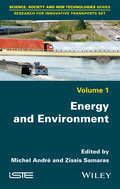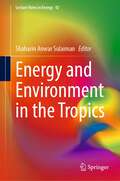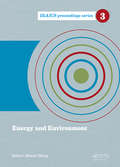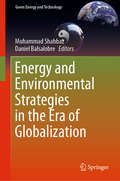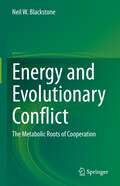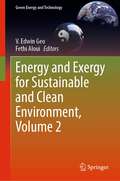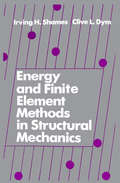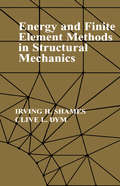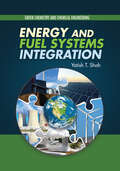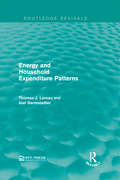- Table View
- List View
Energy and Environment
by Zissis Samaras Michel AndréTransport systems are facing an impossible dilemma: satisfy an increasing demand for mobility of people and goods, while decreasing their fossil-energy requirements and preserving the environment. Additionally, transport has an opportunity to evolve in a changing world, with new services, technologies but also new requirements (fast delivery, reliability, improved accessibility). In this book, recent research works are reported around the triptych: "transport, energy and environment", which demonstrates that vehicle technologies and fuels can still improve, but it is necessary to prepare their implementation (e.g. electro-mobility), to think of new services, and to involve all actors, particularly enterprises, who will be the drivers of innovation. Mitigation strategies are studied to promote innovative, multimodal and clean transports and services. Research progress is reported on air pollution, vibrations and noise, their mitigation and assessment methodologies.
Energy and Environment in the Tropics (Lecture Notes in Energy #92)
by Shaharin Anwar SulaimanThe tropical zones are dominated by developing countries, which mainly face problematic environmental issues. Different than four-season countries, tropical countries have a continuous summer-like season and therefore they are rich in clean energy sources like solar and biomass. Hence, the mitigations of environment and energy issues in the tropics would require specific understanding and different approach to solutions. This book offers an assortment of studies on scenarios of environment as well as energy demand and power generation technologies in the tropics. Many of the countries within the tropics are highly populated, and this results in various problems related to the environment and energy. The demand for energy in these countries keeps increasing but concurrently there are also environmental issues that require serious attention. As the global concern on the environment is alarming today, the choice of power generation should be of the cleanest possible resource. This various reports on research activities carried out in the tropics on the aspect of environment and energy presented in this book are highly beneficial for those who like to see an improvement in the tropics with regard to environment and energy systems.
Energy and Environment: Proceedings of the 2014 International Conference on Energy and Environment (ICEE 2014), June 26-27, Beijing, China (IRAICS Proceedings)
by Dawei ZhengThe 2014 International Conference on Energy and Environment (ICEE 2014) was held June 26-27 in Beijing, China. The objective of ICEE 2014 was to provide a platform for researchers, engineers, academics as well as industry professionals from all over the world to present their research results and development activities in Energy and Environment res
Energy and Environmental Engineering: Proceedings of the 2014 International Conference on Energy and Environmental Engineering (ICEEE 2014), September 21-22, 2014, Hong Kong (Communications in Environmental Science)
by Yijin WuThe 2014 International Conference on Energy and Environmental Engineering (ICEEE 2014) was held September 21-22, 2014 in Hong Kong. This proceedings volume assembles papers from various professionals, leading researchers, engineers, scientists and students and presents innovative ideas and research results focused on Energy and Environmental Engine
Energy and Environmental Outlook for South Asia
by Asif MuhammadSouth Asia constitutes a key geography in the world today considering its large population and related daunting energy and environmental challenges. Many countries in the region are faced with a growing gap between energy demand and local resources, resulting in an increased dependence on imports. According to the International Energy Agency (IEA), the energy demand in South Asia will grow at a rate more than double that of the world average in the coming decades. This book addresses the critical subject of energy and environmental outlook for South Asia and presents the wider challenges and the responses at the national and regional level. Features: Discusses and addresses the ongoing energy and environmental challenges faced by almost a quarter of the global population Includes dedicated chapters for each country and presents analysis and recommendations by regional experts Examines how deteriorating air quality and persistent natural disasters are severe environmental challenges for the region Discusses the implications of global warming and climate change for South Asia Includes practical case studies throughout Energy and Environmental Outlook for South Asia will benefit a wide range of stakeholders from various fields including but not limited to energy, environment, economics, national security, and sustainable development. It also serves as a valuable resource for academics, researchers, analysts, policymakers, and representatives of utilities, industry, professional bodies, financial institutions, think tanks, and developmental organizations to better plan their initiatives, activities, and policies. It will help countries in the region and also those around the world by learning from shared experience, and ideally by collaborating for energy and environmental prosperity.
Energy and Environmental Security in Developing Countries (Advanced Sciences and Technologies for Security Applications)
by Muhammad AsifThis book presents a comprehensive account of the energy and environmental security perspectives of the developing countries. To address the subject comprehensively, it covers four geographically diverse clusters of developing countries from across the world. The regions particularly focused on are: South Asia, South East Asia, Sub Sahara Africa, and Latin America. It is a valuable contribution to the debate, and policy and research activities around the subjects of energy and environmental security in the developing countries and beyond.The book covers the interwoven subjects of energy security and environmental security in the context of developing countries for the first time. It discusses the latest dimensions, challenges, and solutions around taking into account technical, economic, social, and policy perspectives. It incorporates up-to-date data, case studies, and comparative assessment.This edited book has contributions from established as well as emerging scholars from around the world. It benefits a wide range of stakeholders from the fields of energy, environment, and sustainable development. It is of help to academics, researchers, and analysts in these fields besides having appeal for policymakers, and national and international developmental organizations. It also helps developing countries to learn from each other’s experiences.
Energy and Environmental Strategies in the Era of Globalization (Green Energy and Technology)
by Muhammad Shahbaz Daniel BalsalobreThis book provides readers with cutting-edge techniques that can be applied to energy and environmental economics. Further, it highlights the effects that both globalization and economic growth have on the environment. In addition to offering a broader perspective on the relationship between environmental pollution, energy consumption and economic growth, the book studies the relationship between economic growth and environmental damage by drawing on the theoretical hypothesis of the Environmental Kuznets Curve. The book presents new econometric techniques and innovative approaches to the study of the energy economy. Accordingly, it can be used to help analyse the current state of the energy economy, the environment and globalization, and can serve as a theoretical reference manual for doctoral students and academics seeking new analytical techniques.
Energy and Evolutionary Conflict: The Metabolic Roots of Cooperation
by Neil W. BlackstoneIn the mid- to late-twentieth century, large scientific conflicts flared in two seemingly distinct fields of scientific inquiry. In bioenergetics, which examines how organisms obtain and utilize energy, the chemiosmotic hypothesis of Mitchell suggested a novel mechanism for energy conversion. In evolutionary biology, meanwhile, Wynne Edwards strongly articulated the view that organisms may act for the “good of the group.” This work crystalized a long history of imprecise thinking about the evolution of cooperation. While both controversies have received ample attention, no one has ever suggested that one might inform the other, i.e., that energy metabolism in general and chemiosmosis in particular might be relevant to the evolution of cooperation. The central idea is nevertheless remarkably simple. Chemiosmosis rapidly converts energy, and once storage capacity is exceeded, an overabundance of product has various negative consequences. While to some extent chemiosmotic processes can be modulated, under certain circumstances it is also possible to simply disperse the products into the environment.This book argues that these two heretofore distinct scientific disciplines are connected, thereby suggesting that a ubiquitous process of energy conversion may underlie the evolution of cooperation and link major transitions in the history of life that have been regarded as mechanistically unrelated.
Energy and Exergy for Sustainable and Clean Environment, Volume 1 (Green Energy and Technology)
by Fethi Aloui V. Edwin GeoThis multi-disciplinary book presents the most recent advances in exergy, energy, and environmental issues. Volume 1 focuses on fundamentals in the field and covers current problems, future needs, and prospects in the area of energy and environment from researchers worldwide. Based on some selected lectures from the Eleventh International Exergy, Energy and Environmental Symposium (IEEES-11) and complemented by further invited contributions, this comprehensive set of contributions promote the exchange of new ideas and techniques in energy conversion and conservation in order to exchange best practices in "energetic efficiency." Included are fundamental and historical coverage of the green transportation and sustainable mobility sectors, especially regarding the development of sustainable technologies for thermal comforts and green transportation vehicles. Furthermore, contributions on renewable and sustainable energy sources, strategies for energy production, and the carbon-free society constitute an important part of this book.
Energy and Exergy for Sustainable and Clean Environment, Volume 2 (Green Energy and Technology)
by Fethi Aloui V. Edwin GeoThis multi-disciplinary book presents the most recent advances in exergy, energy, and environmental issues. Volume 2 focuses on fundamentals in the field and covers current problems, future needs, and prospects in the area of energy and environment from researchers worldwide. Based on some selected lectures from the Eleventh International Exergy, Energy and Environmental Symposium (IEEES-11) and complemented by further invited contributions, this comprehensive set of contributions promote the exchange of new ideas and techniques in energy conversion and conservation in order to exchange best practices in "energetic efficiency." Included are fundamental and historical coverage of the green transportation and sustainable mobility sectors, especially regarding the development of sustainable technologies for thermal comforts and green transportation vehicles. Furthermore, contributions on renewable and sustainable energy sources, strategies for energy production, and the carbon-free society constitute an important part of this book.
Energy and Finite Element Methods in Structural Mechanics
by Clive L. Dym Irving H. ShamesThis introductory textbook is designed for use in undergraduate, graduate, and short courses in structural engineering and courses devoted specifically to the finite element method. This method is rapidly becoming the most widely used standard for numerical approximation for partial differential equations defining engineering and scientific problems. The authors present a simplified approach to introducing the method and a coherent and easily digestible explanation of detailed mathematical derivations and theory. Example problems are included and can be worked out manually.
Energy and Finite Element Methods in Structural Mechanics (SI Units Edition)
by Irving H. ShamesEnergy and Finite Element Methods in Structural Mechanics (SI Units Edition) by Irving H. Shames.
Energy and Fuel Systems Integration (Green Chemistry And Chemical Engineering Ser.)
by Yatish T. ShahEnergy and Fuel Systems Integration explains how growing energy and fuel demands, paired with the need for environmental preservation, require different sources of energy and fuel to cooperate and integrate with each other rather than simply compete. Providing numerous examples of energy and fuel systems integration success stories, this book:Discu
Energy and Household Expenditure Patterns (Routledge Revivals)
by Joel Darmstadter Thomas J. LareauOriginally published in 1983, Energy and Household Expenditure Patterns claimed that two-thirds of energy consumption in the United States came from households. This study aimed to estimate the expected changes in household activities and how this would affect energy consumption in the country as a whole. Also discussed are implications of direct energy purchases and spending on energy goods in households as well as predicting the growth in energy consumption leading up to the year 2000. This title will be of interest to students of Environmental Studies and Economics.
Energy and Human Resource Development in Developing Countries: Towards Effective Localization
by William HickeyThis book is about engaging and empowering people through their own domestic resources, by using upstream energy to create larger downstream employment opportunities. Incorporating sustainability, resource enhancement, and energy responsibility can generate awareness and better utilization of the resources and reduce reliance on foreign aid and economic development programs, which reinforce a North/ South consumption-based economy rather than empower the localized population. <P><P> The author proposes a new paradigm of employee development, localized engagement, and empowerment for resource-rich developing Asian countries, based on the utilization and upbraiding of their resources in-situ. Here scholars, policymakers, and investors will find that human resource development (HRD) can structure constructive change through criterion-based education and reap economic prosperity.
Energy and Man: A Symposium
by Allan Nevins Robert G. DunlopFirst published in 1960, Energy and Man is a book that comprises five speeches, together with follow-up questions, that were given by business school graduates at a symposium held at Columbia University on November 4, 1959.Contributions by Allan Nevins, Robert G. Dunlop, Edward Teller, Edward S. Mason and Herbert Hoover, Jr., with an Introduction by Courtney C. Brown.“THROUGH THE AGES, LEARNING HAS LOOKED TO THE WORLD of practical affairs for the major subjects of its interest. It is very appropriate that a great university, Columbia, through its Graduate School of Business, should share with a great industry, through its representative, the American Petroleum Institute, an inquiry into the role of energy, past, present, and future, in the lives of each of us.“So, when early in 1959 the American Petroleum Institute asked the Graduate School of Business if it would collaborate in the preparation and presentation of a comprehensive symposium...It was decided that it would be appropriate to consider energy in its several forms and to discuss circumstances that will best assure its continued availability in abundance. Thus, on November 4, 1959, a group of over three hundred government officials, economists, historians, scientists, and executives from a broad range of industry gathered in the rotunda of Columbia’s Low Memorial Library to hear delivered and to discuss the papers which are reprinted in this volume.”—Courtney C. Brown, Introduction
Energy and Mass Transfers: Balance Sheet Approach and Basic Concepts
by Abdelhanine BenallouThis is the first book of a series aiming at setting the basics for energy engineering. This book presents the fundamentals of heat and mass transfer with a step-by-step approach, based on material and energy balances. While the topic of heat and mass transfer is an old subject, the way the book introduces the concepts, linking them strongly to the real world and to the present concerns, is particular. The scope of the different developments keeps in mind a practical energy engineering view.
Energy and Matter (iScience)
by Alton L. BiggsIScience meets students where they are through engaging features and thought-provoking questions that encourage them to relate the science concepts to the world around them.
Energy and Power Systems
by Cornelius T. LeondesThe technical committee on mechatronics formed by the International Federation for the Theory of Machines and Mechanisms, in Prague, Czech Republic, adopted the following definition for the term: Mechatronics is the synergistic combination of precision mechanical engineering, electronic control and systems thinking in the design products and manufa
Energy and Process Optimization for the Process Industries
by Frank ZhuExploring methods and techniques to optimize processing energy efficiency in process plants, Energy and Process Optimization for the Process Industries provides a holistic approach that considers optimizing process conditions, changing process flowschemes, modifying equipment internals, and upgrading process technology that has already been used in a process plant with success. Field tested by numerous operating plants, the book describes technical solutions to reduce energy consumption leading to significant returns on capital and includes an 8-point Guidelines for Success. The book provides managers, chemical and mechanical engineers, and plant operators with methods and tools for continuous energy and process improvements.
Energy and Society: An Introduction, Second Edition
by Harold H. SchobertEnergy and Society: An Introduction, Second Edition provides readers with a detailed introduction to energy sources and energy utilization. This book presents an overview of alternative energy issues and technologies, discusses the pros and cons of various energy sources, and explores their impacts on society and the environment.What's New in the S
Energy and Sustainability: Processes, Modelling and Optimization (Trends in Mathematics)
by Anand Chauhan Harish Chandra JoshiThis volume addresses SDG 7 (Affordable and Clean Energy) and SDG 12 (Sustainable Consumption and Production). By 2030, therefore, people have to substantially increase their share of renewable energy. The book focuses on waste as primary sources of biomass that can fulfill energy requirements for sustainable development. It also discusses various related topics such as energy production methods, a mathematical model for the development of a sustainable biofuels supply chain, economic analysis, optimization techniques, multiple-criteria decision-making and mixed-integer linear programming and existing and emerging policies that encourage the switch to renewable energy. It is committed to fusing science and technology in a way that assures a sustainable future and addresses major topics on biofuels: biomass, bioenergy, biodiesel, bioethanol, biogas modelling and their supply chain management, inventory control and optimization.The 2030 Agenda for Sustainable Development, adopted by all United Nations Member countries in 2015, provides a shared blueprint for peace and prosperity for people and the planet, now and into the future. The book uses an interdisciplinary approach and provides solutions to energy requirements by using emerging technology and nanotechnologies. It explores a technical breakdown of the tools that may be utilized to convert biomass into usable energy forms. At the end of the book, a description of the social and economic aspects of renewable energy and minimization of bioenergy cost is presented. The book is useful to students, researchers, industry experts and anybody in the adoption of renewable energy. It covers the complete course in the fundamentals of biomass feedstock and their supply chain management resources at the graduate level in engineering.
Energy and Sustainable Aviation Fuels Solutions: Proceedings of the International Symposium on Sustainable Aviation 2023 (Sustainable Aviation)
by Alper Dalkiran Ali Haydar Ercan T. Hikmet Karakoç Shau-Shiun Jan Chih-Yung Wu Currao GaetanoSustainable aviation is a long-term strategy to provide innovative solutions to the aviation industry's challenges. The International Symposium on Sustainable Aviation is a multi-disciplinary symposium that presents research on sustainability-based issues and future trends in aviation from an economic, social, and environmental perspective. The conference provides a platform offering insights on a broad range of current topics in aviation, such as improving aircraft fuel efficiency, fostering the use of biofuels, minimizing environmental impact, mitigating GHG emissions, and reducing engine and airframe noise. ISEAS allows researchers, scientists, engineers, practitioners, policymakers, and students to exchange information, present new technologies, and developments. Also, discuss future direction, strategies, and priorities in aviation and sustainability.
Energy and Sustainable Futures: Proceedings of the 3rd ICESF, 2022 (Springer Proceedings in Energy)
by Amin Al-Habaibeh Abhishek Asthana Vladimir Vukovic Jonathan D. NixonThis is an open access book. This book contains research papers presented at the 3rd International Conference on Energy and Sustainable Futures (ICESF), which took place at Coventry University, UK, in 2022. The ICESF is an annual conference organised by the UK-based Doctorial Training Alliance (DTA) programme. It is a multidisciplinary conference focused on addressing the future challenges and opportunities for meeting global energy targets and sustainable development goals. The conference brought together academic researchers, industry experts and research students to showcase the latest innovations and research on a wide range of topics in the areas of energy and sustainability, including • renewable energy; • ICT and control; • computational fluid dynamics; • optimization; • conventional energy sources; • energy governance; • materials in energy research; • energy storage and • energy access.
Energy and protein metabolism and nutrition in sustainable animal production
by Ermias Kebreab James W. Oltjen Hélène LapierreAs world population increases, demand for food and particularly animal products is expected to grow substantially. Because of limited area for expansion of animal agriculture and growing consumer concern for the environmental impact of animal production, gains in animal efficiency will have to be part of the solution. This book addresses key issues of how energy and protein are utilized and interact in farm animals from the molecular to the whole animal and even to the herd or group level of organization. It contains state-of-the-art research and reviews on several topics of nutrient utilization and metabolism from top scientists worldwide. Key issues addressed include energy/protein interactions, methodology such as in vitro and in vivo techniques, regulation including pre-natal programming and endocrine regulation, modeling and systems biology (including a tribute to the late Professor R. Lee Baldwin of the University of California, Davis, a leader in the field), products and health of animals, tissue metabolism, and environmental sustainability in agriculture. This book is a valuable resource for researchers, students, policy makers, producers and industry professionals believing that a better understanding of metabolism and nutrition of farm animals is part of the solution.
